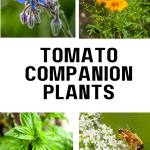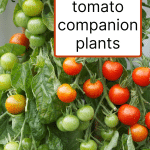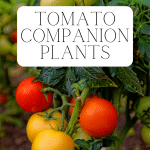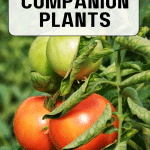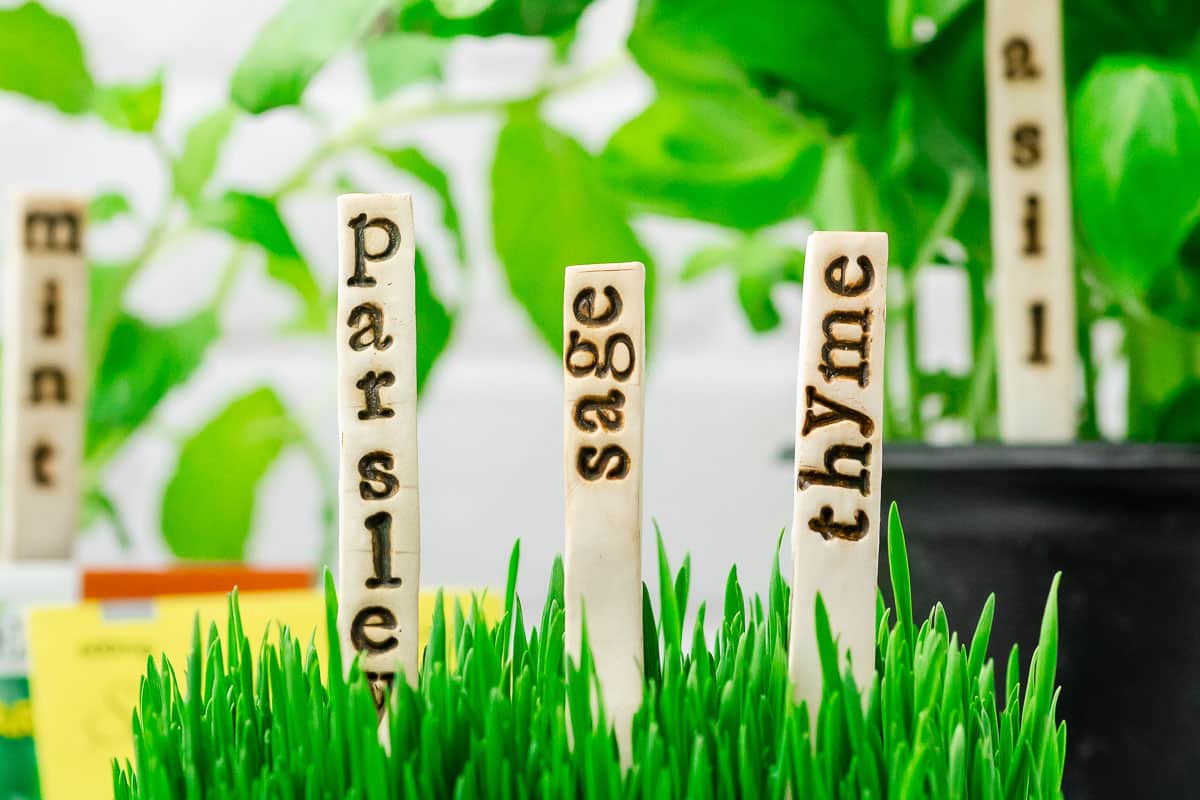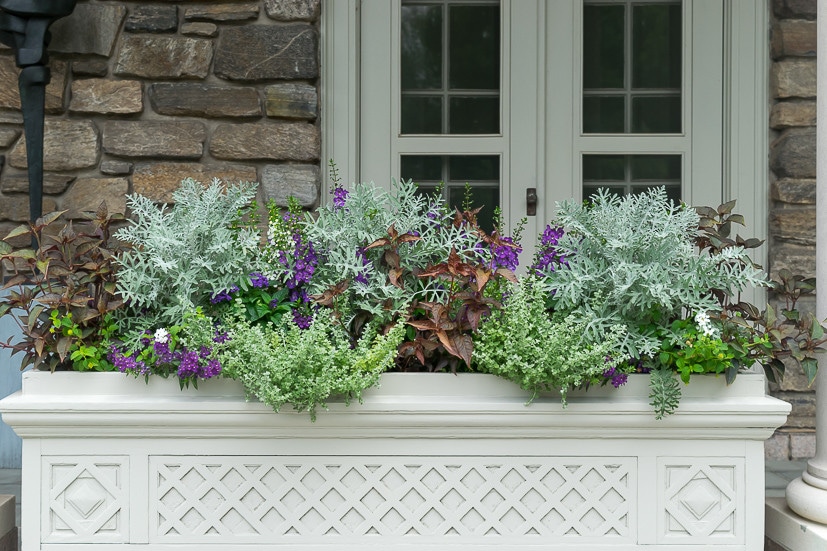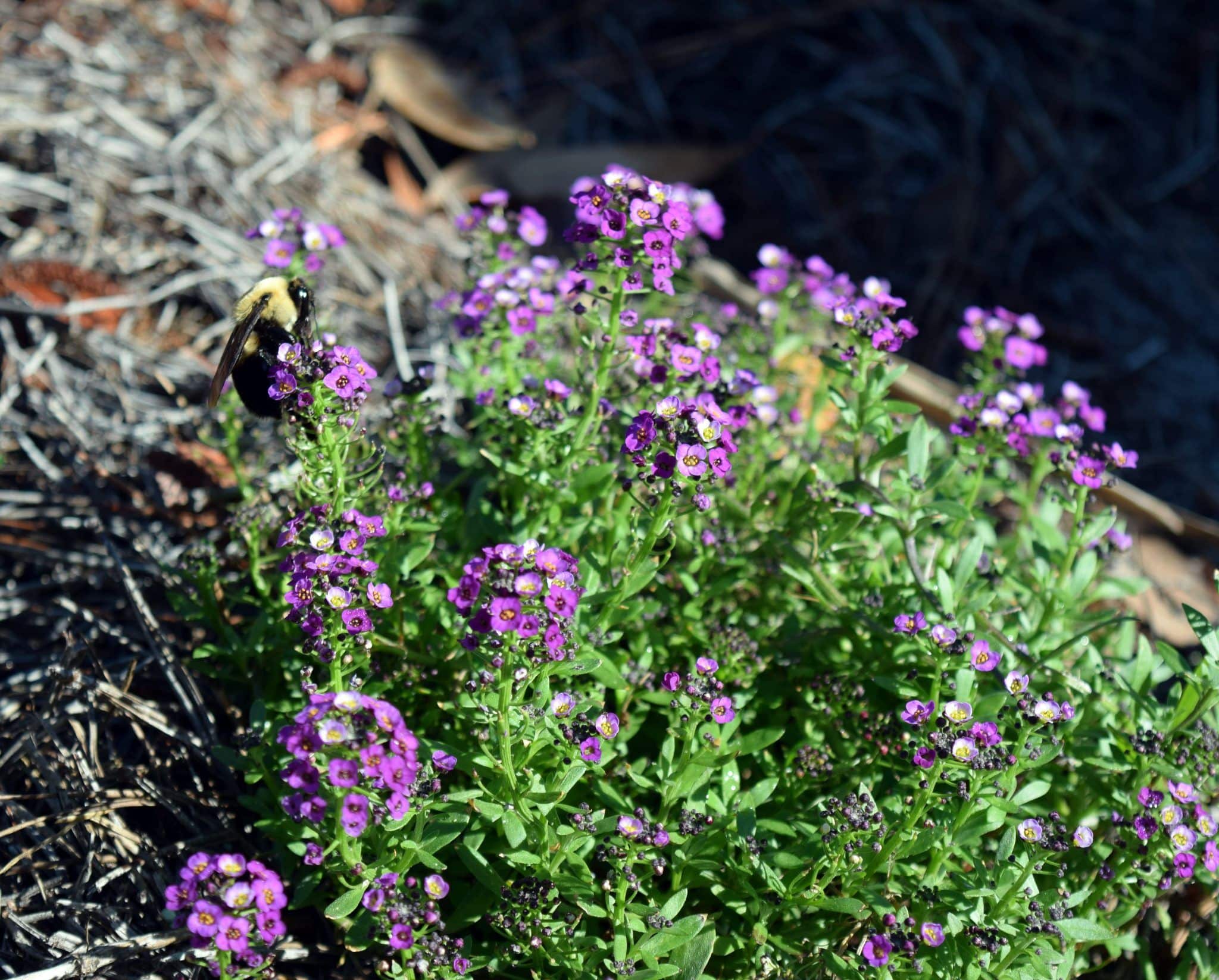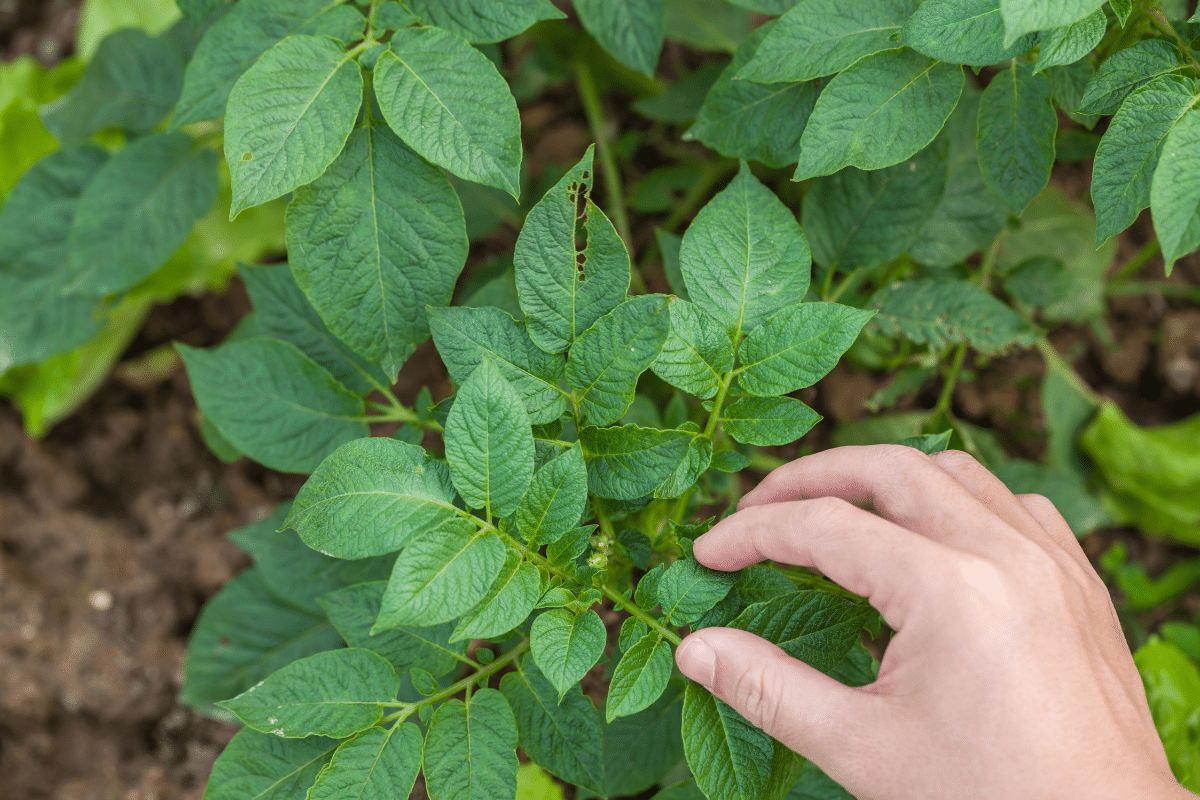Tomato Companion Plants
This tomato companion plants post is part of the series that includes the Companion Planting Guide + Chart, in addition to posts that feature companion plants for strawberries, cucumbers, potatoes, zucchini, pepper, and onions.
Tomatoes are some of the most valuable plants in your at-home gardens. Not only are they delicious when they are sliced and snacked on with a dash of salt and pepper on top, but you can also toss them into so many dishes, whether for breakfast, your mid-day snack, lunch, dinner, or party appetizers. From salsa and tomato soup to BLTs and southern tomato pie, there’s always a way to use these juicy red fruits! As such, many a home gardener pines away until they are able to plant tomatoes and harvest the bounty come mid-sommer.
But how do ensure that you do reap a delicious and bountiful harvest from these somewhat vulnerable and often compromised plants?
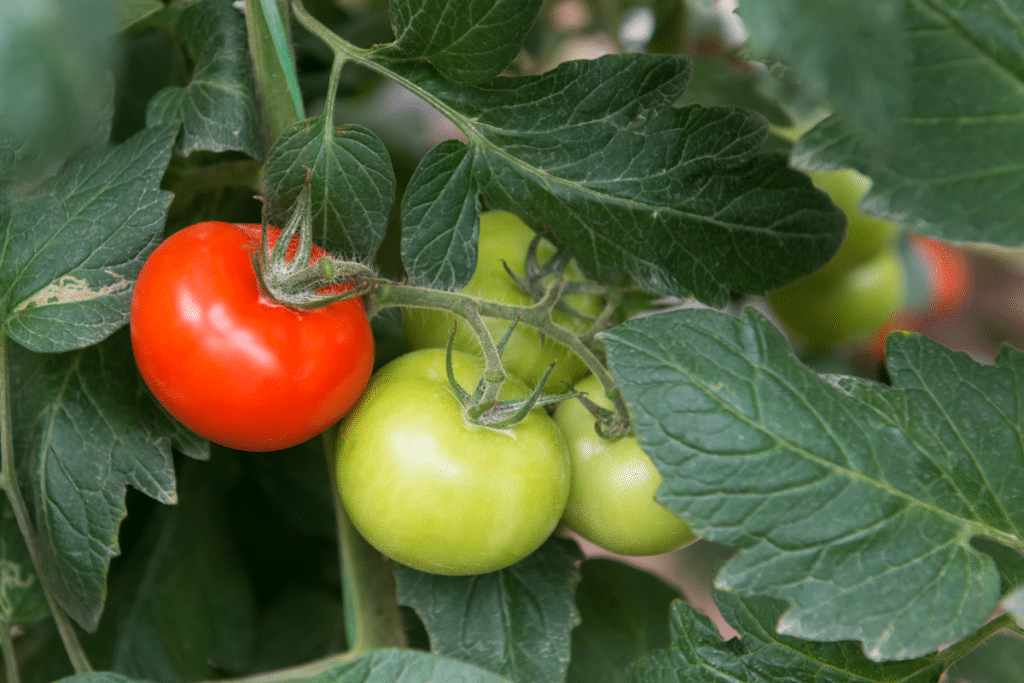
Table of Contents
We will start by exploring how to grow healthy and bountiful tomato plants, including the most common pest and diseases of tomatoes. Then, we will discuss the benefits of using the companion planting technique with your tomato plants. Finally, we’ll introduce you to what to and what NOT to plant along with tomatoes in your garden.
Some of these links may be Amazon affiliate links and I may earn a small commission from the sale of these products to help defray the costs of operating this site, but the price you are charged is not affected. You can see my full disclosure policy here.
common tomatoes pests and diseases
Some common tomato pests and diseases include tomato hornworms, green stinkbugs, flea beetles, aphids, cutworms, nematodes, fusarium wilt, mosaic virus, and verticillium wilt.

Being proactive when planting your garden can help prevent some of these diseases. Some suggestions include the following:
- Start with healthy and rich soil. Healthy plants are much more likely to resist diseases and other problems.
- Don’t overcrowd your garden; provide air space.
- Weeds and debris create spaces where insects can breed and diseases can incubate. Keep your garden plot well-weeded.
- Practice crop rotation so that soil-borne pathogens never have more than a season to get established.
- Remove diseased foliage.
- Don’t compost diseased foliage or plants.
- Water the soil, not the foliage, if possible, especially in humid climates. Many diseases are encouraged by damp conditions.
- Practice companion planting.
Not familiar with companion planting? Before reading on, I encourage you to visit the introduction to this awesome series here. That way, you’ll better understand how and why companion planting works so well!
all about companion planting with tomatoes
In our first post about vegetable garden companion planting, we learned that this method comes down to planting certain plants together for the benefits they offer each other and keeping other plants separated as they can inhibit the growth of one or both.
When it comes to your tomato plants, their best companions are veggies, fruits, herbs, and flowers that can help them thrive by deterring pests and preventing disease. Additionally, some of the tomato’s friends help this vulnerable plant by adding valuable nutrients to the soil and by attracting pollinators and beneficial insects for natural pest control.
In contrast, some plants may be harmful when placed next to tomatoes. For instance, eggplants are in the same family as tomatoes, the nightshades. Because of this, they quickly spread disease to one another, making both plants more susceptible to them. Perhaps you assumed that when you plant species of the same family in one area, they grow better. However, as you have learned, this is not the case, especially concerning disease-prone nightshades.
10 fantastic tomato companion plants
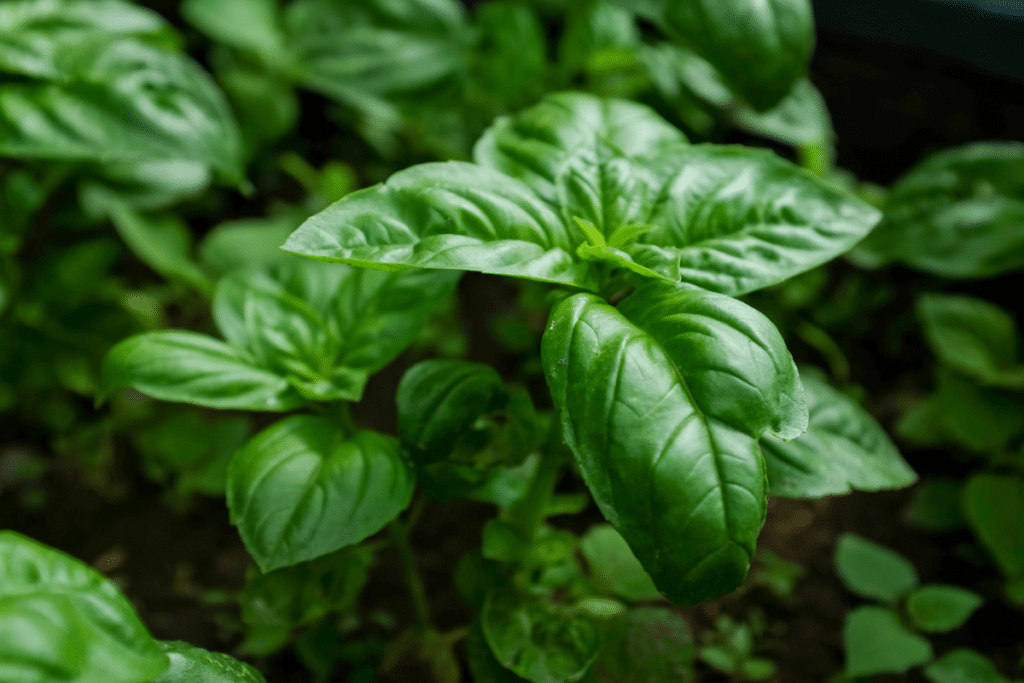
basil
Basil is an excellent tomato companion plant! This fragrant herb pairs well with many crops because of its insect-repelling qualities. Even better, it keeps destructive pests away as effectively as it deters mosquitos and flies! This is a huge help if you live in a humid area or work in your garden later in the afternoon when irritating mosquitos are out and about.
When you place basil near your tomatoes, it even enhances the tomato’s flavor! How could this be? Well, seasoned gardeners and scientists have discovered that herbs with strong scents and flavors often impact the taste of nearby vegetables and fruits. You could get really creative knowing this fact!
clovers
Both crimson clover and red clover are some of the best tomato companion plants. They add nitrogen to the soil, control weed growth as a living mulch, and welcome valuable pollinators to the area, like bees, wasps, and butterflies. Cut it back several times a year to return the nitrogen-rich foliage to the soil.
beans
Beans are light feeders and fix nitrogen soil, making them a good neighbor when planting tomatoes. And as a bonus, this plant also attracts pollinating insects.
borage
If you are unfamiliar with borage, let me introduce you to your new gardening BFF. Bees, hummingbirds, and butterflies belove this fast-growing herb with pretty blue flowers, and is repellant to tomato hornworms and cabbage worms. I don’t know about you, but anything that repels tomato hornworms is instantly my BFF, but the pretty blue flowers are the icing on the cake.

But there’s more! Borage attracts beneficial insects such as parasitic wasps, hoverflies, and lacewings which prey on garden pests.
If you aren’t familiar with parasitic wasps, they are actually pretty cool. They lay their eggs in caterpillars, like tomato hornworms, tent worms, etc… Eventually, the larvae consume the host/pest insect, killing it. If you do see a tomato hornworm with, what looks like grains of rice on its back, let it be! The worm will eventually die, and you’ll have new crops of beneficial, parasitic wasps! (And I’m officially envious!)
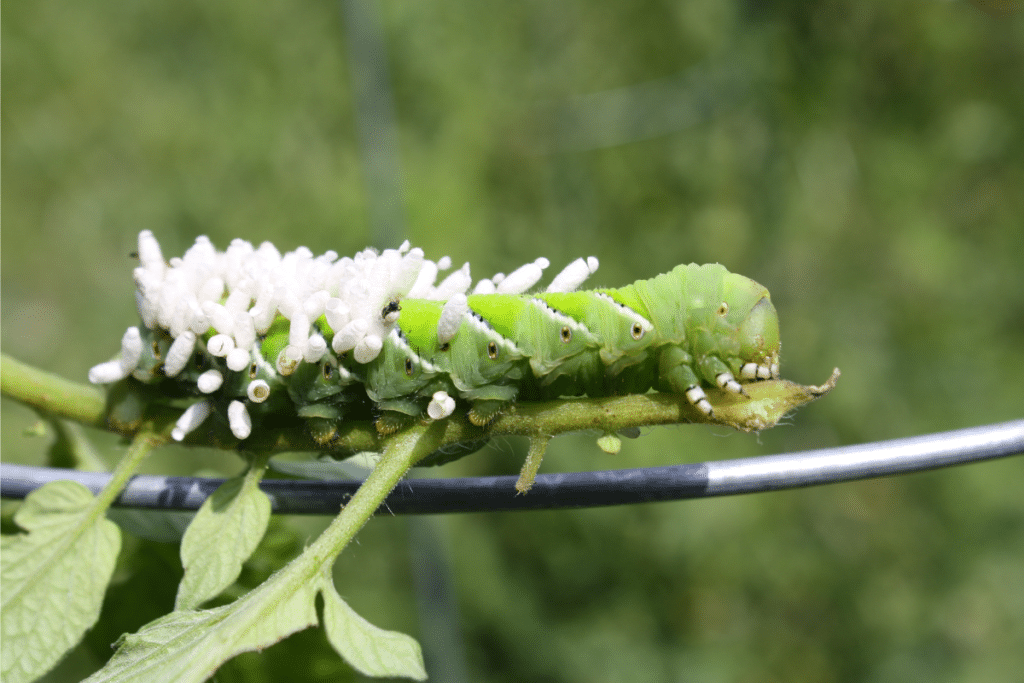
Back to borage, the little blue flowers are edible and have a cucumber taste to them. Use the fuzzy leaves in salads. And many gardeners claim that growing borage near your tomatoes will improve the flavor of your tomatoes.
See, I told you it would be your new BFF. These are the borage seeds I purchased online. They were quick to germinate, and I’ve already planted the seedlings amongst my tomatoes.
herbs
Other herbs besides basil that make excellent companion plants are cilantro, parsley, thyme, and oregano. These herbs help tomatoes grow healthily and produce an abundant harvest by attracting beneficial insects, like predatory wasps, ladybugs, lacewings, and hoverflies, whose primary role in your garden is to consume the damaging pests, like aphids and thrips. Parley attracts hoverflies and can serve as a lure and trap for aphids, keeping them away from the more valuable tomatoes.
If you’ve been struggling to keep yellow-striped armyworms, mosquitoes, earworms, hornworms, and whiteflies out of your garden, thyme is the solution! As a low-growing herb, it also makes a great living mulch.
The beneficial insects and pollinators attracted by herbs’ flowers also will pollinate your tomatoes, aiding in continuous growth and production. Just be sure to let a few of these herbs bloom with flowers rather than always immediately harvesting before they go to seed. The blooms are what attract the insects.

marigolds
And marigolds are pure gold when it comes to being a companion plant. Gardeners have used Marigolds for centuries to battle plant-parasitic nematodes and attract beneficial insects. The roots of marigolds hold a chemical that is nematicidal, insecticidal, and antiviral. However, you can’t plant marigolds once and think you have slayed the nematodes. Nematodes are resilient beasts, so you must keep the marigolds in battle. Marigolds are best when grown as a cover crop before planting your garden. And don’t dig them up; mulch them into the soil at the end of the season.
The beneficial insects attracted by marigolds include hoverflies, ladybugs, and parasitic wasps.
The best marigolds for companion planting are French Marigolds.
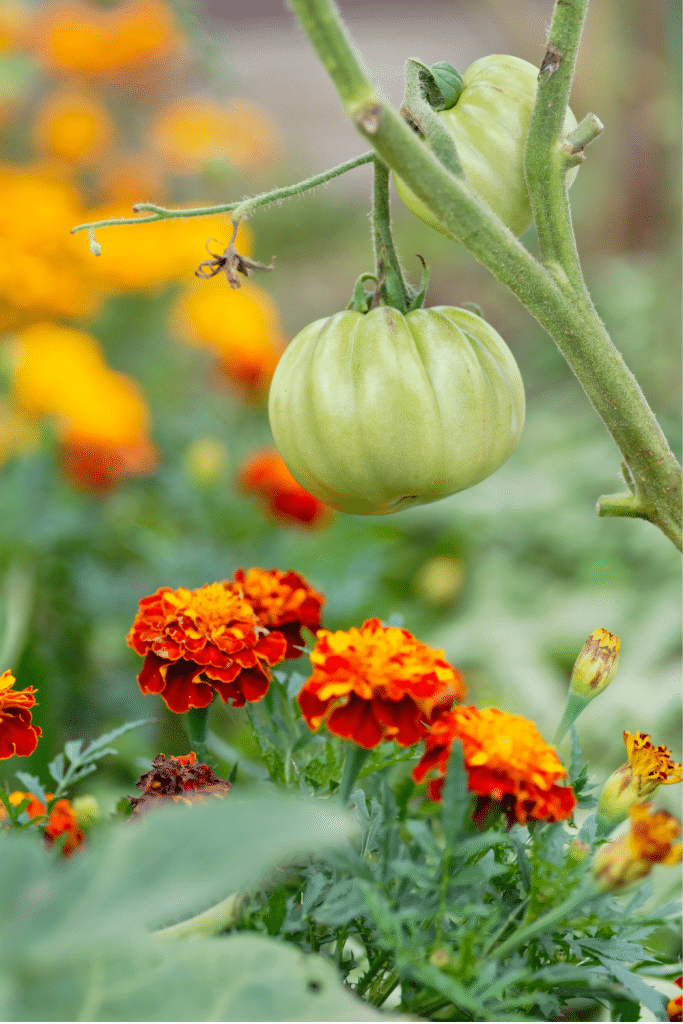
onions + garlic
The scent of garlic and onions repels moths, cabbage loopers, and root maggots.
radishes
If you haven’t yet had much success keeping the flea beetles away from your tomato plants, you may want to surround them with radishes. When you situate the radishes directly next to the tomatoes, they lure the beetles away, acting as a sacrifice to keep the tomatoes healthy and thriving.
sweet potatoes
The way many diseases are spread to tomato plants and other crops is through what is called the “splash-up effect.” In other words, early blight, Septoria leaf spot, and other fungal diseases reach the vulnerable tomato plant when raindrops fall to the ground and splash up, containing the fungal spores in the soil. Sweet potatoes significantly reduce this from happening when they are densely planted all around the base of tomato plants.
sunflowers
Plant sunflowers if you want a fool-proof method of attracting bees and pollinators to your garden! The towering blooms of sunflowers are some of the most successful plants when it comes to increasing pollination. As long as the sunflowers do not overshade certain crops, they’re a great companion plant for almost any species.
a note about asparagus as a tomato companion plant
Tomato plants emit a chemical called solanine, which repels asparagus beetles. Asparagus reciprocates by producing a chemical that repels nematodes. Sounds like they would be great companion plants, right? Unfortunately, tomatoes must be rotated annually while asparagus must stay put, so they aren’t really compatible.
what NOT to plant with tomatoes
Just like there are excellent plants to situate near your tomatoes, there are ones that may risk their growth and survival. For instance, cucumbers aren’t the best plant to have with tomatoes in the garden. In some ways, it is a great companion plant for tomatoes, except for one major issue. Even though they are not part of the nightshade family, they can quickly spread disease to the tomato plant.
And it works the other way around, too. So, the risk outweighs the reward in this case, and you should avoid planting them in the same space.
Check out the following plants that are NOT good tomato companion plants
other nightshades
Peppers, eggplant, and potatoes have the same nutrition requirements and attract similar pests.
brassicas
Cabbage, kale, broccoli, brussels sprouts, cauliflower and tomatoes are both heavy feeders, but brassicas seem to muscle tomatoes out of the way. Accordingly, tomatoes end up malnourished and unhealthy.
strawberries
Strawberries and tomatoes are both prone to Verticillium wilt and anthracnose. That fact is one of the biggest reasons why tomatoes and strawberries are not planted in the same garden, or at least far apart.
cucumbers
Cucumbers need twice as much water as tomatoes and are susceptible to several of the same diseases as tomatoes.
corn
Corn and tomatoes share a common foe; the corn earworm is the same as the tomato fruit worm.
black walnuts
Black walnuts produce a chemical called juglone, which is toxic to all nightshades. Juglone occurs naturally in all parts of the tree, but especially in the buds, nut hulls, and roots.
dill + fennel
And as a final note, you may want to think twice when planting dill and fennel near tomato plants. While they are excellent at deterring pests, they have also been shown to slow tomato growth. Many other herbs, like basil and oregano, can help repel garden pests with little to no risk.
Don’t forget to view and print the companion planting chart and guide to help you choose the right companion plants for your tomatoes. Plus, it’ll show you which ones you need to avoid!
bookmark this post or pin the following image to refer back to this information on tomato companion plants in the future.
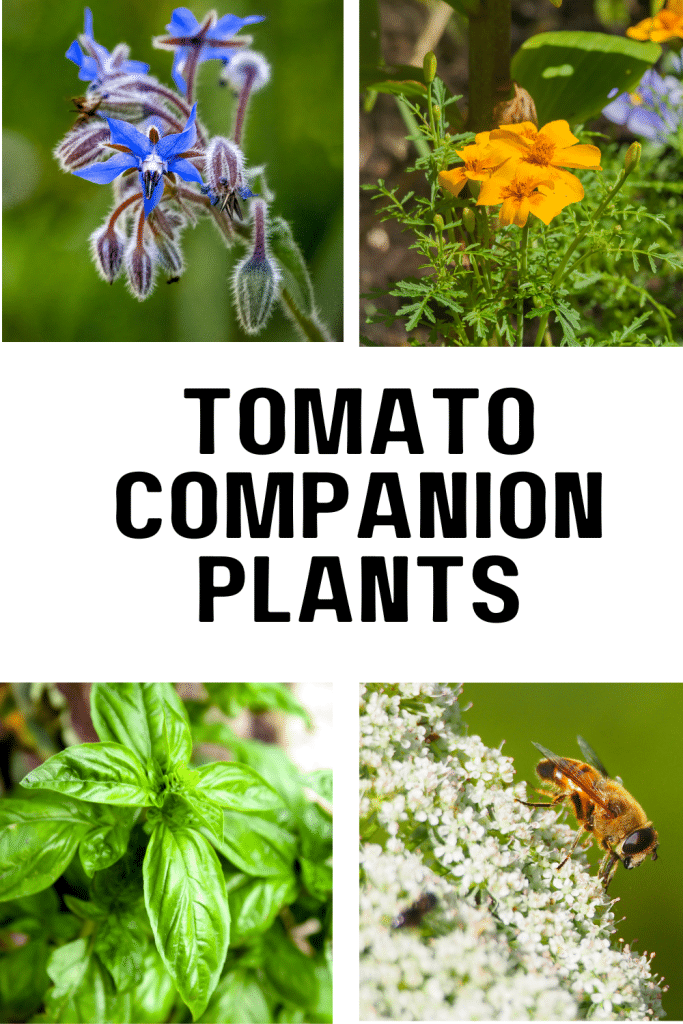
Thanks so much for spending a few minutes of your busy day with me!
To ensure you don’t miss future content, pop your email in the pale green box on the right or click here. I usually send one email weekly, so I won’t inundate your inbox. I’m sensitive to an overflowing email inbox!
We will only use your email address to send you emails, no more than 1-2 weekly. In addition, you will have access to my growing library of knit & crochet patterns and other printables. Check back often as this library will continue to grow. You can unsubscribe anytime by emailing me or clicking on the “unsubscribe” link at the bottom of all emails.
And you can access many of the products I refer to on my Nourish and Nestle Amazon Page. You can access it here.
So, if you’d like to participate in the ‘subscriber benefit’ action, simply subscribe to Nourish and Nestle here or use the form on the right sidebar. It’s slightly towards the top.
I have sent all my subscribers the link to the Subscriber Benefits Library. If you missed it or misplaced it, let me know.
Until next time…


